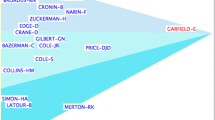Abstract
The online databases of the Dialog System retrieve only 26% of documents in an exhaustively compiled collection on the subject of Bradford's Law of Scattering, with some documents being retrieved from many databases. However, when the Exhaustive Collection is more stringently defined to include only those documents more about the subject, the retrieval rate of Dialog improves to 61%, while its most productive database, LISA, alone retrieves 37%. Both of these ‘samples’ give good estimates of the size-invariant properties of the Exhaustive Collection which are typically studied in Bradford and Growth Analyses—vindicating this use of online searching. However, without additional information, online searches are of little use in determining size-related properties of subject literature collections. Whether the analysis reported here—which relies on identical interpretations of a ‘subject’—has secure foundations is briefly considered.
Similar content being viewed by others
References
Bookstein, A. (1990), Informetric distributions, part II: Resilience to ambiguity,Journal of the American Society for Information Science, 41(5), 376–386.
Bradford, S. C. (1953),Documentation, 2nd. ed., London.
Dialog (1998),DIALINDEX, [http://library.dialog.com/pktguide/dindex.html], 27 September, 1998.
Egghe, L., Ravichandra Rao, I. K. (1992), Classification of growth models based on growth rates and its applications.Scientometrics, 25(1), 5–46.
Egghe, L., Rousseau, R. (1990),Introduction to Informetrics. Quantitative Methods in Library, Documentation and Information Science, Amsterdam.
Nelson, M. J., Tague, J. M. (1985), Split size-rank models for the distribution of index terms,Journal of the American Society for Information Science, 36(5), 283–296.
Oluic-Vukovic, V. (1992), Journal productivity distribution: Quantitative study of dynamic behavior,Journal of the American Society for Information Science, 43(6), 412–421.
Wilson, C. S. (1995),The formation of subject literature collections for bibliometric analysis: The case of Bradford's Law of Scattering, PhD. Dissertation, School of Information, Library and archive Studies, University of New South Wales, Sydney.
Wilson, C. S. (1998), Defining subject collections for informetric analyses: The effect of varying the subject aboutness level.Scientometrics, 41 (1–2), 209–223.
Author information
Authors and Affiliations
Rights and permissions
About this article
Cite this article
Wilson, C.S. Using online databases to form subject collections for informetric analyses. Scientometrics 46, 647–667 (1999). https://doi.org/10.1007/BF02459618
Received:
Issue Date:
DOI: https://doi.org/10.1007/BF02459618




